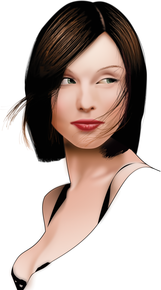Inking It In
Besides basic drawing functions, Inkscape provides sophisticated effects that can transform vector lines into soft, flowing brushstrokes or automate the drawing of paper-fine lines.
|

Luciano Lourenco, Free Art License, wiki.softwarelivre.org/InkscapeBrasil/Imagem108
Besides basic drawing functions, Inkscape provides sophisticated effects that can transform vector lines into soft, flowing brushstrokes or automate the drawing of paper-fine lines.
Inkscape is known as a drawing program, because image elements in an Inkscape document depend on lines (called vectors ) and not colored pixels like you use in bitmap programs. Its sometime association with randomly scattered sketches doesn't do the program with all its many effects full justice.
In its current version 0.48, Inkscape [1] can create images that are more like hand-painted watercolors than pencil drawings. However, these images are still based solely on lossless, scalable vector shapes (Figure 1).
This article will deal primarily with basic shapes and Bézier curves, which use control points to form basic shapes. Their smooth transitions and intuitive handling make them the digital equivalent of the French curve tool used by draftsmen. Since my previous Inkscape article appeared in our sister publication Linux Magazine [2] in 2005, nothing much has changed from Inkscape's solid base.
[...]
Pages: 4
The Inkscape vector graphics program not only lets you work with pencil and ink lines, it can help you mimic the elegant brushstrokes of an oil painting. Our three easy-to-follow examples show you how.
Printing firms currently market their services on the Internet and printing has never been cheaper. Linux provides two programs, Inkscape and Scribus, that together produce high-quality print artwork.
Would you like to adorn your letterhead with an attractive Celtic knot? Drawing one by hand is a laborious task, but Knotter provides a variety of functions to get the job done in a matter of minutes.
GIMP by itself can already do a lot. With plugins, you can extend the free image editor with complex functions, most of which allow you to see the final results before you apply them.
© 2026 Linux New Media USA, LLC – Legal Notice